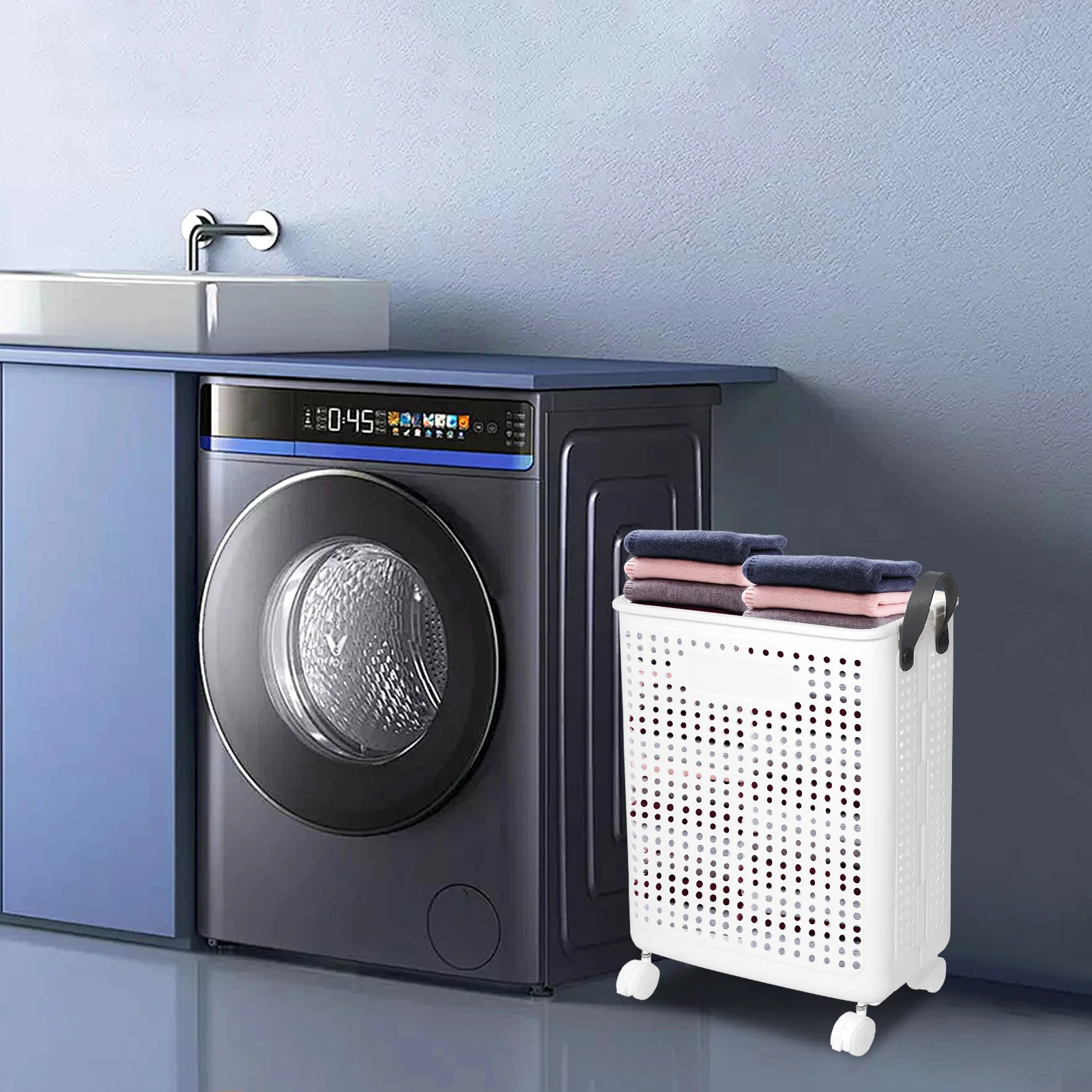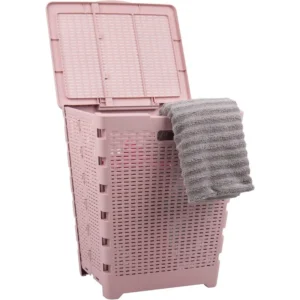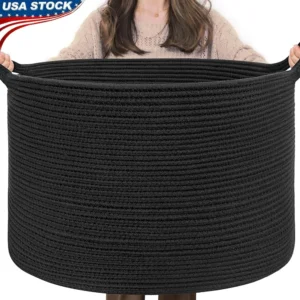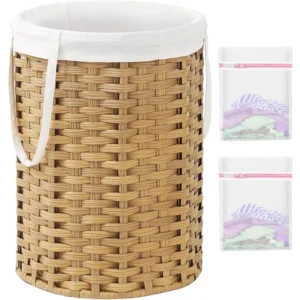Understanding the Basics: What Sets Lidded and Open Hampers Apart
When organizing your laundry routine, one of the first decisions you’ll face is choosing between lidded and open hampers. These two options serve the same basic purpose but differ significantly in functionality and design.
Lidded hampers feature a top covering that completely conceals your dirty laundry. This design creates a sealed environment and often doubles as an aesthetic piece of furniture. The transformative benefits of lidded laundry hampers extend beyond simple storage to include odor control and visual organization.
Open hampers, by contrast, have no covering, allowing for maximum airflow and easier access. They typically prioritize ventilation and convenience over concealment.
Key differences between these styles include:
- Concealment: Lidded designs hide dirty clothes from view while open designs keep contents visible
- Ventilation: Open hampers offer superior airflow; lidded ones provide more limited air circulation
- Aesthetics: Lidded options often blend with furniture while open designs tend to be more utilitarian
Though the terms are sometimes used interchangeably, there are subtle differences between hampers and baskets. Generally, laundry hamper vs. basket differences come down to structure and intended use – hampers typically being sturdier, stationary units while baskets often emphasize portability.
Both styles come in various materials including wicker, rattan, plastic, metal, and fabric – each offering different benefits regarding durability, breathability, and visual appeal.
Complete Comparison Chart: Lidded vs. Open Hampers at a Glance
Before diving into detailed analysis, this side-by-side comparison highlights the key differences between lidded and open hamper designs to help you quickly assess which might better suit your needs.
| Feature | Lidded Hampers | Open Hampers |
|---|---|---|
| Odor Control | Excellent (contains odors) | Fair (allows odors to dissipate) |
| Ventilation | Limited | Excellent |
| Aesthetic Impact | High (hides clutter) | Moderate (contents visible) |
| Ease of Access | Requires two hands to use | Simple one-handed access |
| Mildew Risk | Higher (especially in humid areas) | Lower (better airflow) |
| Concealment | Complete | None |
| Portability | Often heavier, less portable | Generally lighter, more portable |
| Space Efficiency | Can double as surface space | Only serves as hamper |
| Child/Pet Access | Restricted | Easily accessible |
This comparison highlights how each hamper type excels in different areas. For those particularly concerned with both functionality and appearance, understanding the wicker laundry hampers vs. baskets comparison provides additional insights into material-specific benefits.
The Case for Lidded Hampers: Benefits That Matter
Superior Odor Containment
Lidded hampers excel at containing odors, making them ideal for shared living spaces. The enclosed design creates a barrier that keeps unpleasant smells from permeating your home. This feature is particularly valuable in smaller homes or apartments where laundry areas might be close to living spaces.
Enhanced Visual Organization
One of the most significant advantages of premium lidded hamper options is their ability to instantly reduce visual clutter. By concealing dirty laundry, these hampers create a more serene environment that contributes to an organized, tidy-looking space.
Privacy and Discretion
In shared households or when entertaining guests, lidded hampers offer privacy for personal items. They keep intimate apparel and stained clothing discreetly hidden, which many find more comfortable in shared bathrooms or bedrooms.
Protection from External Elements
The covering on lidded hampers provides protection from dust, curious pets, and exploring children. This barrier keeps your dirty laundry separated from other environmental factors until wash day.
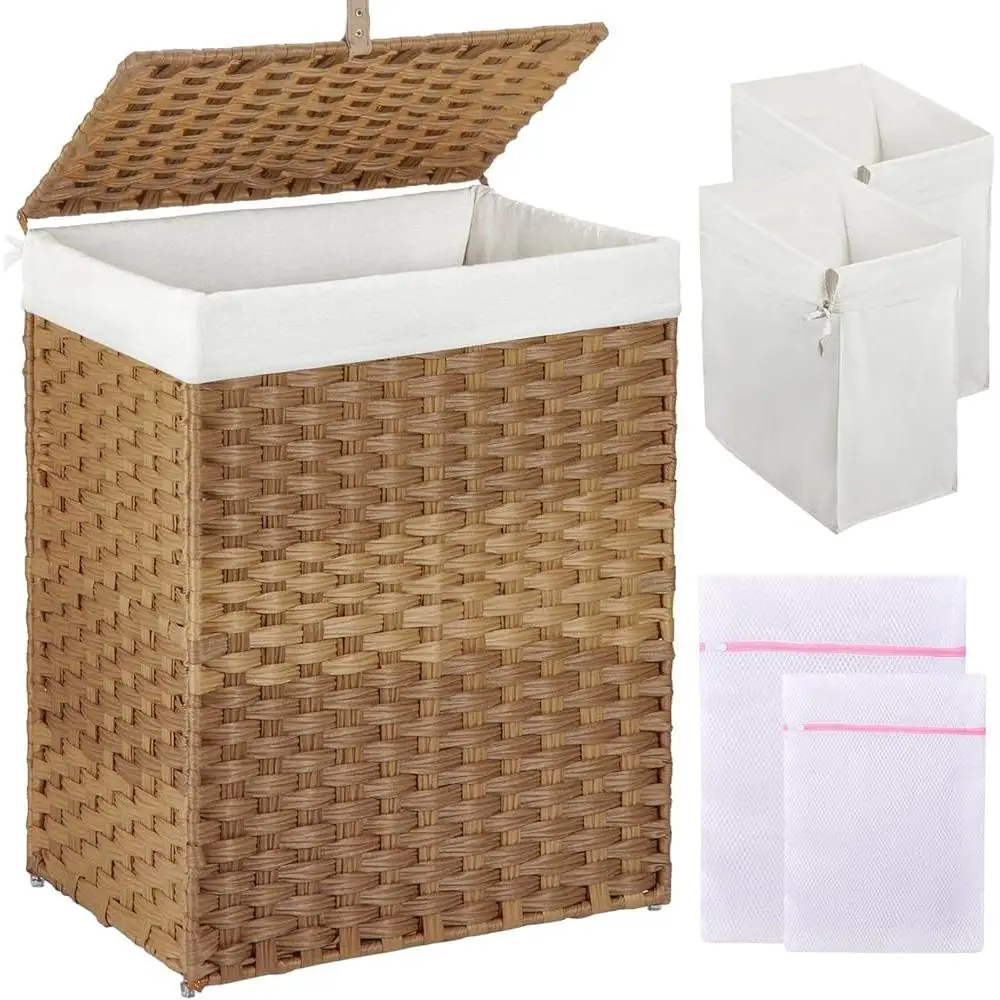
Multifunctional Surface Space
Many reasons to choose a lidded laundry hamper include their ability to double as functional surfaces. Flat-topped designs can serve as nightstands, side tables, or display areas in bathrooms and bedrooms, maximizing space efficiency in smaller homes.
Design Statement
Premium lidded hampers crafted from wicker or rattan make beautiful design statements that complement your décor rather than detracting from it. These pieces seamlessly integrate into your home’s aesthetic while serving a practical purpose.
Potential Drawbacks of Lidded Designs: What to Consider
While lidded hampers offer numerous advantages, they aren’t without limitations that deserve consideration before making your choice.
Ventilation Challenges
The primary concern with lidded designs is reduced airflow. Limited ventilation can trap moisture from damp towels or sweaty clothes, potentially leading to musty odors developing over time. This issue becomes more significant in naturally humid environments or with hampers placed in bathrooms.
Usability Considerations
Lidded hampers require an extra step each time you add laundry:
* Opening and closing the lid requires two hands
* The additional motion makes quick deposits more cumbersome
* Lids can become damaged with repeated use if not well-constructed
Moisture Management Issues
Without adequate airflow, moisture from damp items can create an environment where mildew might develop. However, many best lidded hampers for odor control feature ventilation holes or specialized designs to mitigate this concern.
Space Requirements
Lidded designs often have a larger footprint and height requirement, making them less suitable for tight spaces like closets or under counters. Their structure typically demands more room than their open counterparts.
Cost Considerations
Quality lidded hampers generally come with a higher price tag due to the additional materials and more complex construction. This price difference becomes more pronounced with premium materials like handwoven wicker or rattan.
The Advantages of Open Hampers: Simplicity and Airflow
Unmatched Ventilation
The defining feature of open hampers is their superior airflow. Without a lid creating a barrier, air circulates freely through your laundry, helping to:
* Prevent moisture buildup
* Reduce odor development
* Allow damp items to dry partially before wash day
* Minimize mildew risk, even in humid environments
Convenience and Accessibility
Open designs prioritize ease of use in daily life. Their simple construction allows for:
* One-handed deposits of dirty clothes
* Quick visual assessment of laundry volume
* Easier sorting capabilities when needed
* No mechanical parts that might break or wear out
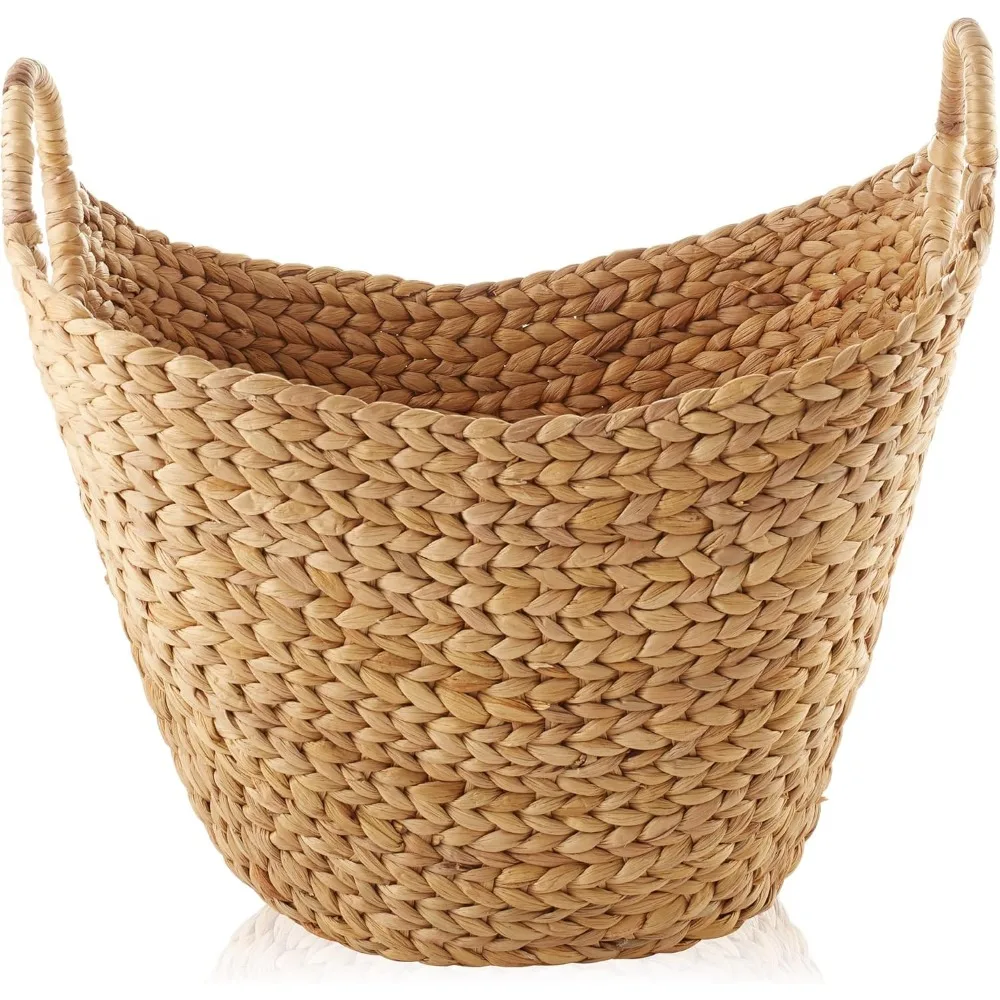
Enhanced Portability
Most woven laundry baskets without lids feature lightweight designs and often include handles, making them ideal for carrying laundry to and from washing machines. This transportability is particularly valuable in homes where laundry facilities are located away from bedrooms or bathrooms.
Cost-Effective Solutions
Open hampers typically require less material and simpler construction, resulting in more affordable options across all quality levels. This cost efficiency makes them particularly appealing for secondary hampers or when outfitting multiple rooms.
Visual Reminders
The visible nature of open hampers provides a practical reminder of when laundry needs attention. This visual cue can help maintain regular washing routines before laundry piles become overwhelming.
Limitations of Open Designs: When They Fall Short
Despite their practical benefits, open hampers come with several drawbacks that might make them less suitable for certain situations.
Visual Clutter Concerns
The most obvious limitation is their inability to hide dirty laundry. In visually sensitive spaces like bedrooms or bathrooms that guests might use, exposed dirty clothes can create a perpetual sense of disorder, regardless of how organized the rest of the room might be.
Odor Distribution
Without containment, strong odors from dirty gym clothes, work uniforms, or soiled items can spread throughout your living space. This issue becomes particularly noticeable in smaller homes or apartments where living areas are close to laundry storage.
Accessibility to Pets and Children
Open designs provide no barrier to curious pets or children. Cats may find them perfect for napping, dogs might see them as treasure troves of interesting scents, and toddlers could easily empty them during momentary distractions.
Dust and Environmental Exposure
Without protective covering, laundry in open hampers collects dust, hair, and other airborne particles. This exposure might necessitate rewashing clothes that have sat too long before being laundered.
Limited Aesthetic Integration
While some designer open hampers exist, they generally present more challenges in seamlessly integrating with sophisticated home décor, often appearing more utilitarian than decorative.
Material Matters: How Construction Affects Performance
The material of your laundry hamper significantly influences both its functionality and longevity, regardless of whether you choose lidded or open designs.
Natural Fiber Excellence
Natural materials like those found in wicker laundry baskets offer distinct advantages:
Wicker: Typically made from rattan, willow, or reed, these hampers combine durability with natural breathability. Their woven structure allows for air circulation even in lidded designs.
Rattan: Premium rattan hampers feature exceptional strength-to-weight ratios and natural resistance to humidity, making them ideal for bathroom placement.
Seagrass: These hampers bring unique textural elements while providing good ventilation. They tend to be more rigid than other natural fibers.
Synthetic and Metal Options
Plastic: Offering waterproof properties and easy cleaning, plastic hampers work well in high-moisture environments but provide less breathability.
Canvas and Fabric: These lightweight, often collapsible options provide good breathability but may absorb odors over time and require more frequent washing.
Metal: Wire mesh designs maximize airflow while providing structure, though they offer little privacy and may rust in humid environments.
Construction Considerations
Beyond material type, construction quality directly impacts performance:
* Tight, consistent weaving patterns in natural materials indicate quality craftsmanship
* Reinforced edges prevent unraveling or damage during daily use
* Smooth finishes prevent clothing snags
* Proper joinery ensures long-term structural integrity
Premium construction ultimately determines how well any hamper performs its core functions, sometimes making a well-built lidded hamper more breathable than a poorly constructed open one.
Decision Framework: Matching Hampers to Specific Home Environments
Finding the perfect laundry hamper depends largely on where you’ll place it and how your household operates. This framework helps you match the right hamper type to your specific circumstances.
Bathroom Placement
Bathrooms present unique challenges with high humidity levels:
* Best choice: Ventilated lidded hampers in natural materials
* Why: Provides odor containment while still allowing moisture to escape
* Avoid: Fully sealed plastic hampers that trap humidity
* Consider: Taming laundry chaos with lidded hampers designed specifically for high-humidity environments
Bedroom Solutions
Bedrooms benefit from hampers that blend with décor while maintaining functionality:
* Best choice: Decorative lidded hampers in matching design styles
* Why: Offers visual harmony while containing laundry out of sight
* Material recommendation: Wicker or rattan for breathability and aesthetics
Closet and Laundry Room Placement
Utility spaces prioritize function over appearance:
* Best choice: Open hampers with sorting capabilities
* Why: Maximizes efficiency and ventilation in spaces where appearance is less critical
* Consider: Stackable or nestable options to maximize vertical space
Small Space Living
Compact homes require multifunctional solutions:
* Best choice: Slim profile lidded hampers that double as furniture
* Why: Maximizes limited square footage with dual-purpose items
* Features to prioritize: Height rather than width, flat tops for additional surface area
Family Considerations
Households with children or pets have special requirements:
* Best choice: Lidded hampers with secure closures
* Why: Prevents access by curious children or pets
* Alternative: Elevated open hampers out of reach of small children and animals
Wicker Laundry Baskets, Woven Laundry Baskets, Woven Storage Baskets
$392.02 Select options This product has multiple variants. The options may be chosen on the product pageWoven Laundry Baskets, Woven Laundry Washing Baskets
Price range: $136.76 through $581.37 Select options This product has multiple variants. The options may be chosen on the product pageWicker Hampers with Lids, Wicker Laundry Baskets with Lids, Wicker Laundry Hampers
$127.33 Select options This product has multiple variants. The options may be chosen on the product pageWicker Blanket Baskets, Woven Laundry Baskets
$89.60 Select options This product has multiple variants. The options may be chosen on the product pageLarge Wicker Laundry Baskets, Rattan Laundry Baskets, Woven Laundry Hampers
$162.32 Select options This product has multiple variants. The options may be chosen on the product pageWoven Laundry Baskets, Woven Laundry Hampers
$166.90 Select options This product has multiple variants. The options may be chosen on the product page
Hybrid Solutions: Getting the Best of Both Worlds
For those finding it difficult to choose between lidded and open designs, several innovative options combine benefits from both styles.
Ventilated Lidded Hampers
These smart designs feature lids with built-in ventilation slots or perforations that:
* Maintain the visual concealment of dirty laundry
* Allow for improved airflow to reduce moisture buildup
* Provide odor containment while preventing mildew issues
* Offer the aesthetic benefits of lidded designs without sacrificing functionality
Divided Compartment Systems
Multi-section hampers provide versatile solutions:
* Separate compartments for different laundry categories (colors, whites, delicates)
* Options with both lidded and open sections for different item types
* Space-efficient sorting that streamlines laundry day processes
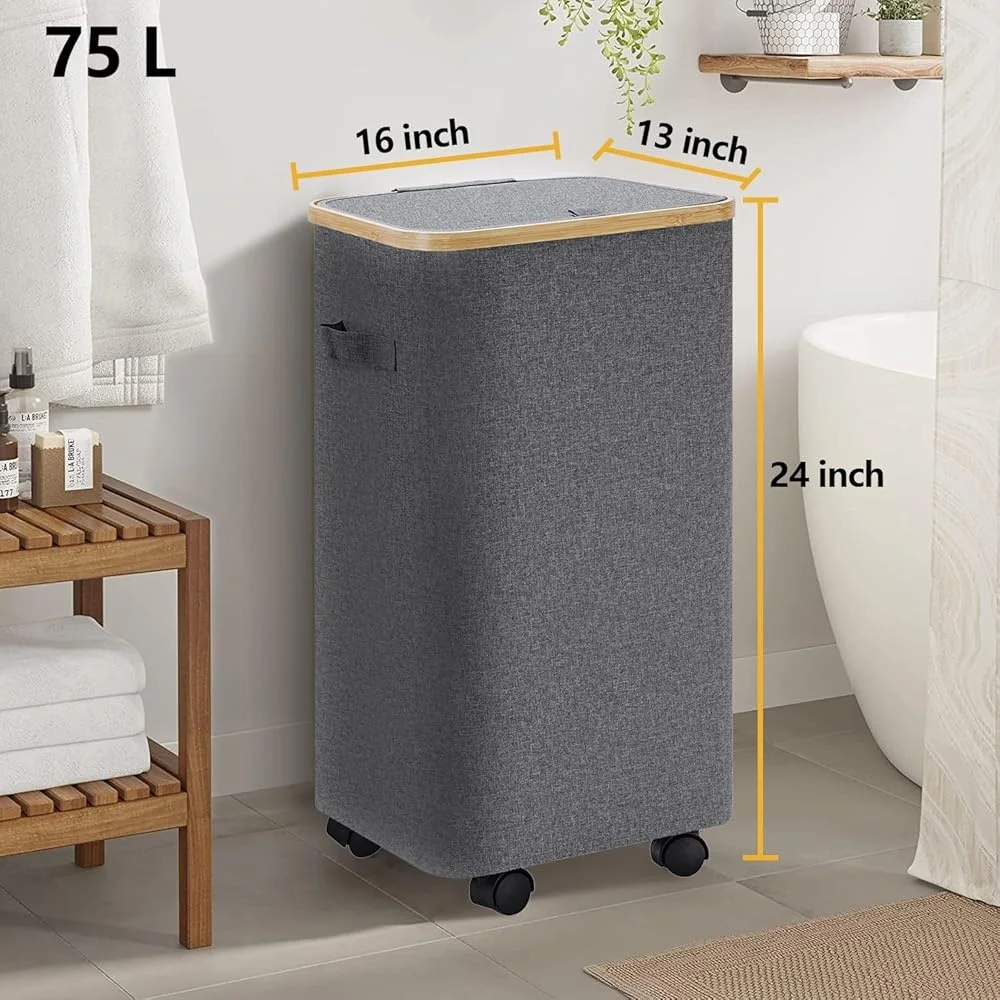
Tilt-Out and Drop-Front Designs
These innovative hampers feature:
* Partial openings that provide easier access than traditional lids
* Better ventilation than fully lidded options
* Attractive furniture-like appearance that conceals contents
* Space-saving designs ideal for tight corners or small bathrooms
Decorative Screens and Partial Covers
For those who prefer open hampers but want some visual screening:
* Decorative room dividers can shield open hampers from direct view
* Semi-open designs with partial coverings offer a middle-ground approach
* Hamper covers that can be added or removed as needed provide flexibility
Expert Maintenance Tips: Keeping Any Hamper Fresh and Functional
Regardless of which hamper style you choose, proper maintenance ensures longevity and hygiene.
Handle damp items properly: Avoid placing soaking wet items directly in any hamper. Allow them to dry partially before adding them to your laundry collection, especially in lidded hampers.
Regular cleaning schedule: Empty and clean your hamper monthly. For premium rattan laundry baskets, use a soft brush to remove dust and debris from weaving patterns.
Material-specific care:
* Natural fibers: Occasional sunning helps eliminate odors and moisture
* Fabric liners: Remove and wash every few weeks
* Plastic: Wipe down with antibacterial cleaner monthly
* Metal: Check periodically for rust, especially in bathroomsStrategic placement: Position your hamper away from direct heat sources and extremely damp areas. Even open designs benefit from reasonable airflow around their perimeter.
Respect capacity limits: Overloading hampers stresses seams and weaving, potentially causing structural damage. Multiple smaller hampers often work better than forcing everything into one oversized container.
Use laundry bags: For especially odorous items or delicates, consider using small mesh laundry bags before placing in your main hamper.
Deodorize naturally: Place a small sachet of baking soda, activated charcoal, or essential oil-infused cotton balls near (not in) your hamper to absorb odors without damaging materials.
Your Lifestyle, Your Choice: Making the Final Decision
After considering all factors, your final hamper selection should reflect your specific lifestyle needs and priorities.
If maintaining a visually organized space tops your list, lidded hampers provide the cleaner aesthetic. Those sharing living spaces or with children and pets will also appreciate the concealment and restricted access these designs offer.
Conversely, if your primary concerns are ventilation and preventing mildew, especially in humid climates, open designs deliver superior airflow. Those who value convenience and simplicity in their daily routines may prefer the straightforward accessibility of open hampers.
Consider your laundry habits honestly. Do you tend to let laundry accumulate for longer periods? A ventilated lidded design might work best. Do you wash clothes frequently? An open hamper might provide all you need with better breathability.
Remember that construction quality matters more than price. A well-crafted hamper in either style will provide better value than a poorly made alternative, regardless of initial cost. Tidy Treasure emphasizes quality construction across all hamper styles, ensuring whichever type you choose performs its function beautifully for years to come.
Frequently Asked Questions About Laundry Hampers
Do lidded laundry hampers cause mildew?
Lidded hampers can create conditions for mildew if they trap moisture without ventilation. Look for designs with built-in ventilation features or practice proper laundry management by allowing wet items to dry before placing them in lidded hampers.
Are open hampers unhygienic?
Open hampers aren’t inherently unhygienic, but they do collect dust and allow odors to circulate. Regular cleaning and timely laundry washing prevent most hygiene concerns with open designs.
Which type is better for preventing smells?
Lidded hampers contain odors within the hamper itself, while open hampers allow odors to dissipate but potentially throughout your living space. For overall odor management, ventilated lidded designs often provide the best compromise.
Can I use a laundry basket as a stationary hamper?
Yes, though traditional laundry baskets are designed for transport rather than long-term storage. Look for baskets with sturdy construction and good ventilation if repurposing them as stationary hampers.
What are the best materials for laundry hampers?
Natural materials like wicker, rattan, and seagrass offer excellent breathability while providing durability. These materials work well in both open and lidded designs, combining functionality with aesthetic appeal.
How often should I clean my hamper?
Clean your hamper monthly by emptying it completely and wiping down interior surfaces. Natural fiber hampers benefit from occasional sunning outdoors to eliminate odors and moisture naturally.

